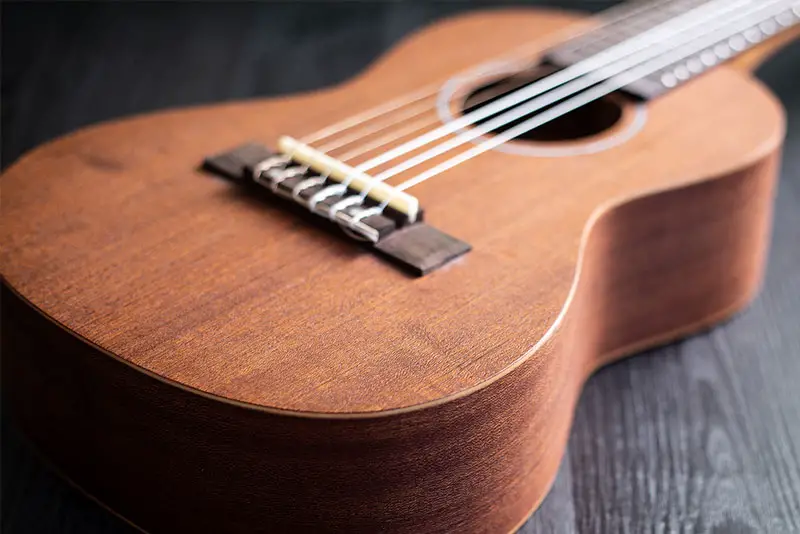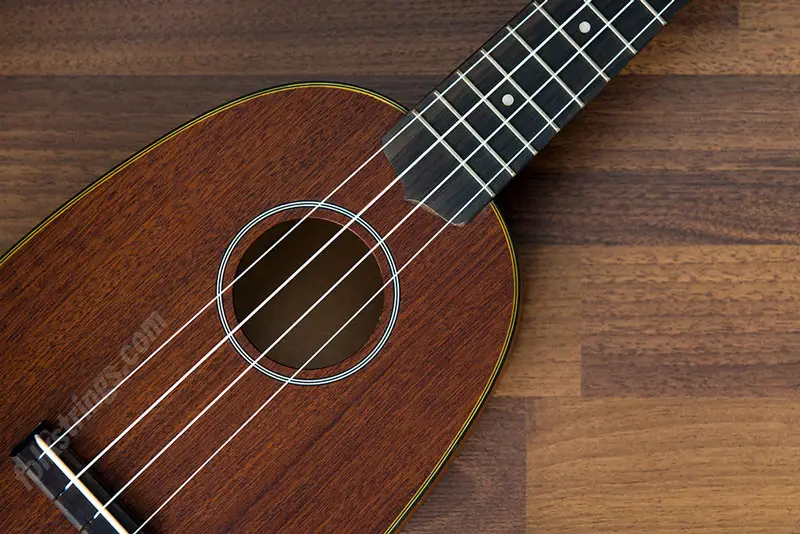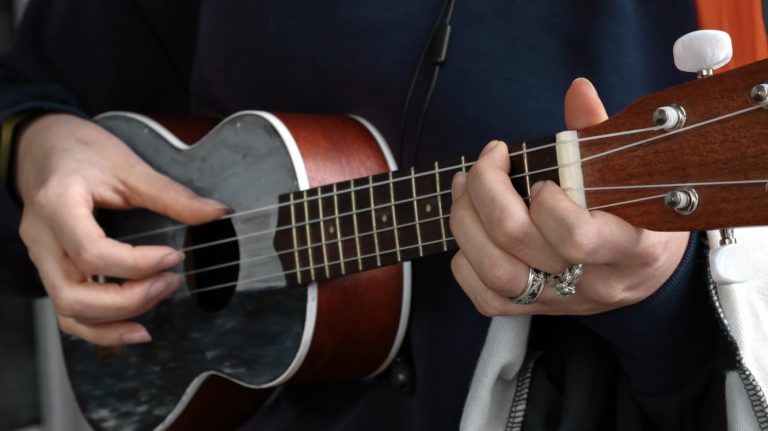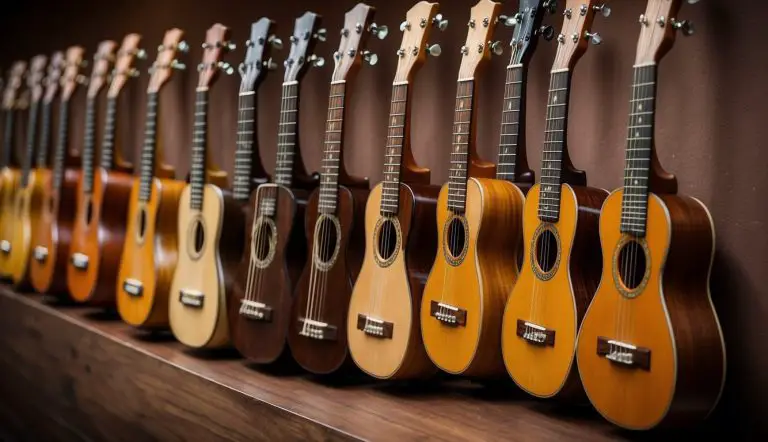Learning The Ukulele – Ukelele Questions for Beginners Part 1 – Honest Answers to Common Questions!
Folkstrings.com is reader-supported. When you buy through links on our site, we may earn a small commission.
When someone starts learning to play any instrument there are a few common ukulele questions they may ask, like: Can you strum a ukulele with your thumb? How often should you change ukulele strings? Why does my ukulele sound weird? Are ukulele strings plastic? All of these are great questions that will be answered in this article.
Learning the ukulele for beginners can prove to be a daunting task, but it is totally achievable with the right guidance and resources.
Remember – if you have a question that isn’t answered in this article, do browse the rest of our ukulele articles or leave a comment with your question in the section below this article and one of our writers will try and respond…There’s no question too big or too small. Learning an instrument or anything new for that matter is not easy for everyone.
Table of Contents
Can You Strum A Ukulele With Your Thumb?
The question of ‘Can you strum a ukulele with your thumb?’ is quite a common one, more specifically whether there is a hard rule as to whether you should use your thumb or fingers when playing the ukulele. The answer is, yes, you can strum a ukulele with your thumb.
Many people prefer to play using their thumbs as they have found it more comfortable and effective for playing. It is similar to playing guitar or bass.
It can take some time to get used to it but it is certainly possible with the correct technique and you will be strumming in no time!
You may find your fingers are more effective when playing certain types of ukulele songs. For example, you could use one of your fingers to play the melody or solo sections of a song where it just requires strumming along with the melody.
Are there any advantages to using your thumb to strum?
Yes, for some people it is more comfortable and effective. Some people find that the sound produced when strumming with their fingers isn’t to their liking. Others just prefer to use one of their fingers because they are trying to play classic fingerstyle ukulele songs, where each finger plucks a different string simultaneously.
How Many Strings Are On a Ukulele?
A standard ukulele typically has four strings, including the soprano ukulele, which is the smallest and most common type of ukulele.
However, there are also variations of the ukulele that have more strings, such as six-string and eight-string ukuleles.
The four strings on a ukulele are usually tuned to the notes G, C, E, and A, with the G string being the lowest-pitched string and the A string being the highest-pitched string.
The tuning of the strings can vary depending on the style of music being played and the personal preferences of the musician.
Why Does My Ukulele Sound Weird?
It sounds too loud? Too quiet? Too sharp? Too flat?? Is it just me, or…?
Ukuleles are known to have problems such as these. They’re often called ‘tinny‘, and the reason is that the ukulele itself makes a high-pitched sound.
There are several ways to solve these problems. These methods will introduce a ‘plunky’ ukulele sound that you can be proud of.
The following tricks apply to both acoustic and electric ukuleles.

Adjusting the Ukulele’s Strings
This is the most important factor in giving you a well-rounded sound. High strings and low strings will cause an imbalance, making your ukulele sound like it doesn’t know how to stay in tune or make each note cleanly.
This can be easily fixed by tuning your ukulele properly.
If you tune your ukulele and the strings still feel and sound out of wack, then it may be time to change them. Make sure the gauge of the string is correct for your type of ukulele (folk vs. classical) before changing anything. The easiest way to do this is with a tuner.
The next step is adjusting their height above the fretboard so they are all the same volume. Strum each string one by one, and you will notice that some sound louder than others. If this is happening to you, you should change their height before anything else so they can be at equal volume.
Using a Capo
A capo is a tool that clips onto your ukulele’s neck and holds down the strings at any given fret. This allows you to play in any key without having to transpose anything.
This means, if you have a problem with too many sharps or flats, a capo is a solution. Of course, you can’t just put a capo on and play your entire song without changing any of the chords you’ve already learned, but it’s helpful if you’re trying to learn new songs or just change the key for an easier version.
Another way that a capo is useful for this problem is by adjusting the tension of the strings. If you find your high E string is much louder than the rest, try putting a capo on the third fret and see if it makes a difference.
Using a ‘Silencer’ or ‘Mute’
These accessories clip onto your ukulele’s bridge so that the strings can’t vibrate. This will greatly lower the volume of your ukulele, but it can be surprising how much sound comes out from those tiny strings.
To use one of these accessories, you have to remind yourself that it’s not a chord mute. You aren’t just ‘muting’ random chords for effect; you’re muting all of them so that you can use open strings for new chords.
Also, it is very important that you don’t ‘tap’ on the mute with your fingers like you would on a drum. If you want to add percussion effects (such as flamenco strums), then pick the muted string instead of tapping it. This will give it a nice percussive effect without interfering with the sound.
Changing the Ukulele’s Strings
If you’ve already tried all of these tricks and more, but are still having problems producing a clean sound or staying in tune, then it might be time to change the strings.
There are two things you should consider when looking for new strings:
-Do you need high or low tension? High is very easy to play, especially for beginners. Low tension may be hard to play at first, but it allows more flexibility and volume with your strumming and individual notes.
-Do you plan on using a capo? This will determine the material you should use. For example, nylon strings are great for capos, classical strumming, and folk music.
Some ukes even come with these pre-installed.
Depending on the type of ukulele you have, you can change them yourself or take it to a professional. It’s not difficult at all if you follow step by step instructions like this one:

How Often Should You Change Ukulele Strings?
Really, unless you play every day, it’s really up to you. Burning through strings is not something that happens in any sort of time frame so when they start sounding bad is when they should be changed.
Some people change them when they start getting dull looking, some when they break and some keep the same string for months at a time. The best answer is to change them when they start sounding dull. If you’re not sure they’re dull, play them and if they don’t sound like how they usually do (bright or mellow) then it’s time to change them. Trust your ears.

What are Aquila Nylgut strings?
Aquila Nylgut strings are ukulele strings that comprise many materials, twice as much nylon as gut (hence the name), iron, tin, copper, and silver. Nylgut is a trademark of theirs and what makes them special.
Nylgut strings are designed specifically for the ukulele and fit perfectly on the instrument and, according to users, give it an amazing sound. There are other strings available, but Aquila Nylgut is a popular choice among ukulele players.
Are Ukulele Strings Plastic?
Ukulele strings are usually nylon, but there are some made out of metal. For a beginner, nylon is fine but as you become more experienced, try changing to metal strings.
Metal strings produce a louder sound and if you play in a band, they can really make a difference. Nylon strings are less harsh on the ears when played for an extended amount of time.
Nylon is also much cheaper than metal, which is why they are more popular for beginner ukulele players. But some experienced ukulele players use nylon. It all comes down to preference.
Can Ukulele Strings Break Easily?
Ukulele strings are tougher than they look, so it would take a lot to bend them out of tune or break them. However, if someone is lacking in finger strength or you have extremely tight tuners on your uke, they might be more likely to break.
There is nothing wrong with replacing your strings, it is good practice and they usually only cost around $4 anyway.

Where Can I Sell My Ukulele?
This one’s easy. eBay is by far the most popular place to sell your ukulele. Craigslist is another popular option too, but eBay has by far more protection from scammers or anything that may go wrong than Craiglist does.
Are Ukuleles Hard To Play?
Ukuleles are not as hard as you think they may be. The strings on a ukulele, if you have never played one before, can be quite thin.
This will take some getting used to, but once you do, it is easier than it looks. If this is your first time playing the uke I suggest using a smaller uke for easier maneuvering of the neck. I also suggest using a strap because it takes the tension off of your hands and arms, which can become very tiring.
Once you have had some practice, then invest in a bigger ukulele that will produce larger sounds.
Author Profile
-
Daniel Johnstone is an English writer with a love for stringed instruments from around the world.
He shares his love for these instruments through his writing for folkstrings.com, a website dedicated to all things related to folk string music.
Daniel's passion for music started at a young age, and he has since become an accomplished musician, playing guitar, cavaco, and recently, the harp.
His dedication to learning and sharing his knowledge of stringed instruments is evident in his insightful and engaging blog posts. Whether you're a seasoned musician or a beginner, Daniel's writing is sure to inspire and entertain you.
When he's not playing music or writing, you can find Daniel exploring new instruments and seeking out new sounds to share with his readers.
Latest entries
 AutoharpApril 4, 2024What Is the Autoharp Made Of: Exploring Its Materials and Craftsmanship
AutoharpApril 4, 2024What Is the Autoharp Made Of: Exploring Its Materials and Craftsmanship AutoharpApril 4, 2024Is Autoharp Easy to Play? Unveiling the Truth for Beginners
AutoharpApril 4, 2024Is Autoharp Easy to Play? Unveiling the Truth for Beginners AutoharpApril 4, 2024What Is an Autoharp Worth? Your Guide to Pricing and Value
AutoharpApril 4, 2024What Is an Autoharp Worth? Your Guide to Pricing and Value AutoharpApril 4, 2024Are Autoharp and Zither the Same Thing? Unraveling String Instrument Myths
AutoharpApril 4, 2024Are Autoharp and Zither the Same Thing? Unraveling String Instrument Myths
Affiliates:
This post may contain affiliate links that at no additional cost to you, the site may earn a small commission. We only recommend products we would use ourselves and all opinions expressed on this site are our own.
Accuracy Advice:
While we strive to provide up-to-date and accurate information, the content in this article may not reflect the most current research or medical guidelines. We encourage readers to do further research and consult with professionals for more personalized advice.
Our Recommendations:
The products and services mentioned in any of our articles are recommended based on our independent research and personal experience. We are not sponsored by any company. We aim to suggest products and services we believe are of high quality and could be beneficial to our readers.








